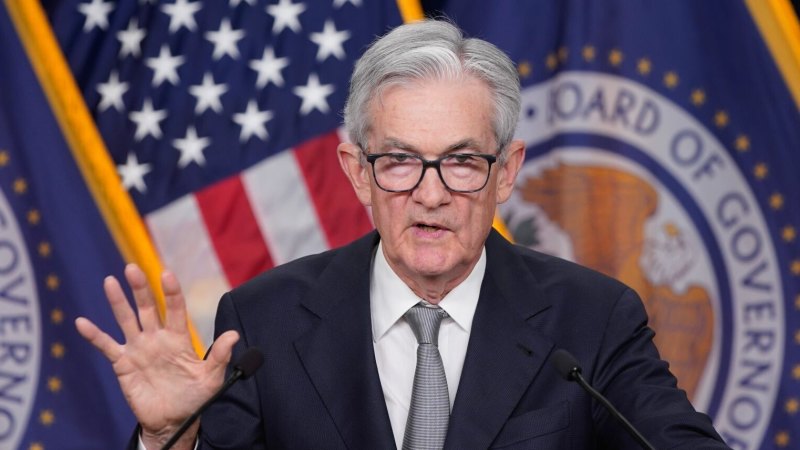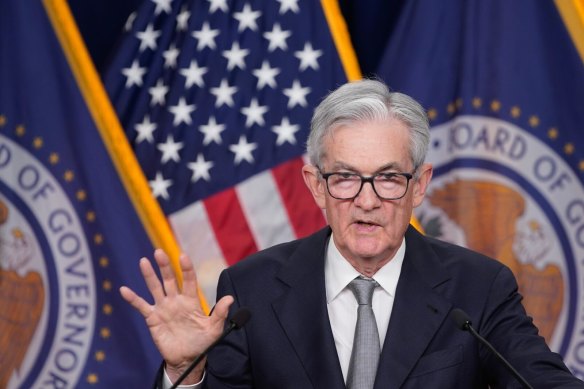
With all eyes on the Fed, it’s the US Treasury that saves the day
November 2, 2023Save articles for later
Add articles to your saved list and come back to them any time.
The US Federal Reserve Board’s decision to leave interest rates on hold may have dominated headlines, but the more significant news overnight was a US Treasury announcement of its quarterly debt-issuance plans.
While Fed chair Jerome Powell left the possibility of a December rate hike open and said the central bank was not confident it had yet done enough to bring the US inflation rate down to its target of 2 per cent, yields in the bond market fell and stocks rose after the Treasury announcement.
Federal Reserve chair Jerome Powell as he explained the US central bank’s latest rate decision.Credit: Bloomberg
Essentially, Treasury said it would issue less long-dated government debt than the market had anticipated, instead increasing the size of its auctions of two and five-year notes. That followed an announcement on Monday which revealed, with tax receipts running more strongly than expected, the total issuance this quarter would be modestly lower than anticipated.
It was the maturity structure of Treasury’s plans, however, that caused yields to slide.
Since Treasury’s last refunding statement in August, there has been a massive sell-off of bonds and yields – which have an inverse relationship with bond prices, rising as the value of bonds falls – have spiked to 22-year highs.
Investors were spooked by the sheer scale of the supply of bonds, particularly longer-dated bonds, scheduled to hit the market when price-sensitive private sector investors are the primary source of demand, given that the Fed is allowing securities it acquired with its quantitative easing program in response to the pandemic to mature without reinvestment and other central banks are largely absent as buyers.
In effect, over the past three months the market has been doing the Fed’s job for it.
Between Treasury’s August refunding statement and their peak late last month, the yields on two-year notes had risen from about 4.75 per cent to 5.22 per cent and the yield on 10-year bonds – the most influential benchmark for global financial assets – from about 4 per cent to, momentarily, just above 5 per cent.
It was a bond market rout – one that inflicted losses of multi-billions, perhaps trillions, of dollars for investors in the $US25 trillion market ($39 trillion) – triggered by the scale of demand the US government was adding to the market and the amount of long-term debt the market was being asked to absorb as a result of the $US1.7 trillion US budget deficit.
The surge in yields reflected the return of a term premium (the compensation for the risk of holding bonds that won’t mature for a decade or even more) that had effectively been suppressed by the Fed’s unconventional monetary policies since the financial crisis in 2008.
In effect, over the past three months the market has been doing the Fed’s job for it. While it has left the federal funds rate unchanged since its July meeting, the market has effectively added the equivalent of about four of the Fed’s usual 25 basis point rate rises to the US rate structure, tightening financial conditions significantly.
Powell referred to the higher yields at his press conference after the Fed’s formal statement, saying conditions had clearly tightened, with households and businesses now paying higher rates. That would, over time, have an effect on the economy, potentially easing price pressures and slowing growth.
A similar situation has arisen in Australia, probably driven by the need for local yields to compete with those in the US to attract investors.
The Reserve Bank has left the cash rate unchanged at 4.1 per cent since it last increased it by 25 basis points at its June meeting, but since that meeting, the yields on two-year notes have jumped from 3.88 per cent to 4.46 per cent and 10-year bond yields from about 3.8 per cent to 4.95 per cent.
While there seems to be an expectation that the RBA has at least one more rate rise to go in this cycle, perhaps at next week’s Melbourne Cup Day meeting, the market has been doing a lot of the heavy lifting for it. Like the Fed, it will have to factor in the impact on the economy of the increased cost of borrowing on consumers and businesses that the market activity will drive.
When the Fed’s rate-hiking cycle started in March last year, the effective federal funds rate was close to zero.
Despite 11 rate rises – including four oversized 75 basis point moves last year – and a 5.5 percentage point increase in that rate, along with the Fed’s $US95 billion a month of quantitative tightening, the US economy has been remarkably resilient. It grew at an annualised rate of 4.9 per cent in the September quarter and the unemployment rate of 3.8 per cent is around historic lows.
That may be because of the Biden administration’s fiscal stimulus and big (and probably unsustainable) deficits, but consumer spending has remained very strong even after the pandemic-era injections of cash into households ended.
It could also be that the impact of the aggressive run-up in the federal funds rate last year and into the first half of this year and the Fed’s steady shrinking of its balance sheet as its bond holdings run off without reinvestment have yet to have their full impact on the economy.
The US inflation rate has been falling, much like in other developed economies, but more slowly than the Fed would have hoped. US core inflation, excluding food and energy prices, has halved from its 5.6 per cent peak last year.
There are long lags between increases in interest rates and their impact on economic activity, which explains why the Fed has (like the RBA) kept its policy rate on hold since mid-year.
Neither Powell nor his peers want to drive their economies into recession with monetary policy overkill if they can avoid it, which is why Powell has, as he did again this week, consistently talked about the option of raising rates further while leaving them on hold and downplaying and pushing out the prospect of eventual rate cuts.
The recent steep run-up in bond market yields adds another layer of uncertainty and another reason for central bank caution.
With the “bond vigilantes” back on the job and demanding more compensation for risk after their long hibernation, the pressure on central banks to do all the unpleasant work in combatting inflation has eased a little.
The Business Briefing newsletter delivers major stories, exclusive coverage and expert opinion. Sign up to get it every weekday morning.
Most Viewed in Business
From our partners
Source: Read Full Article



